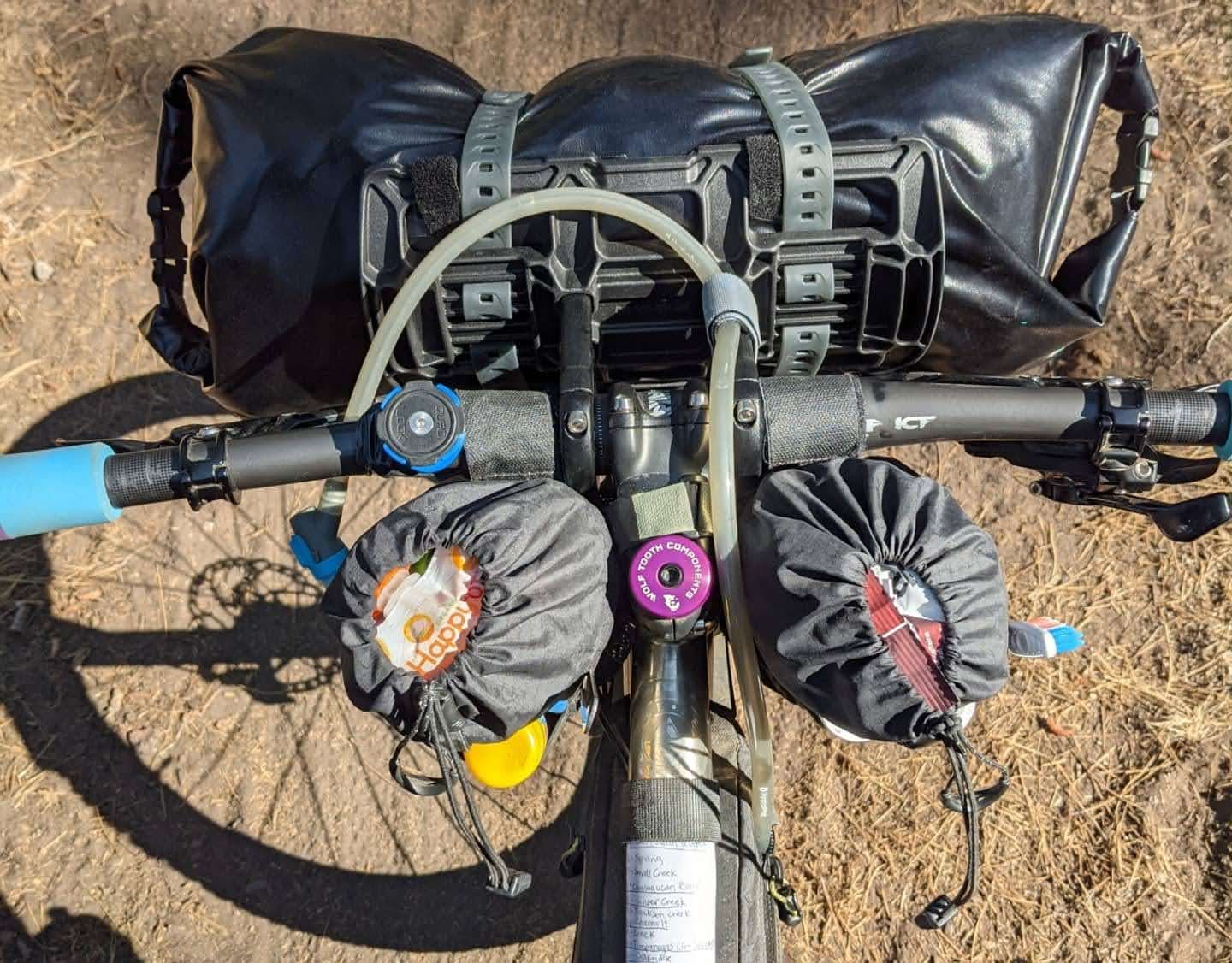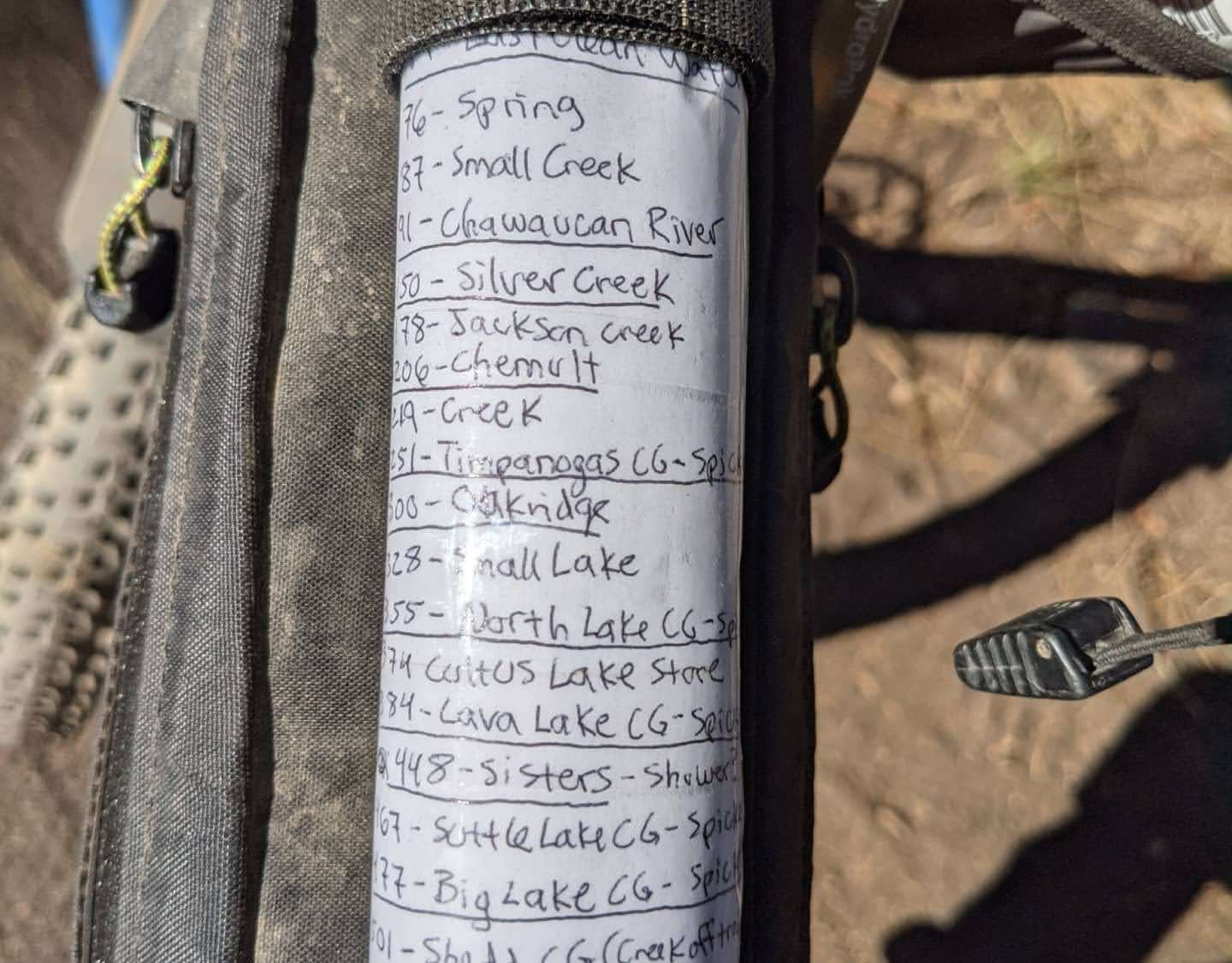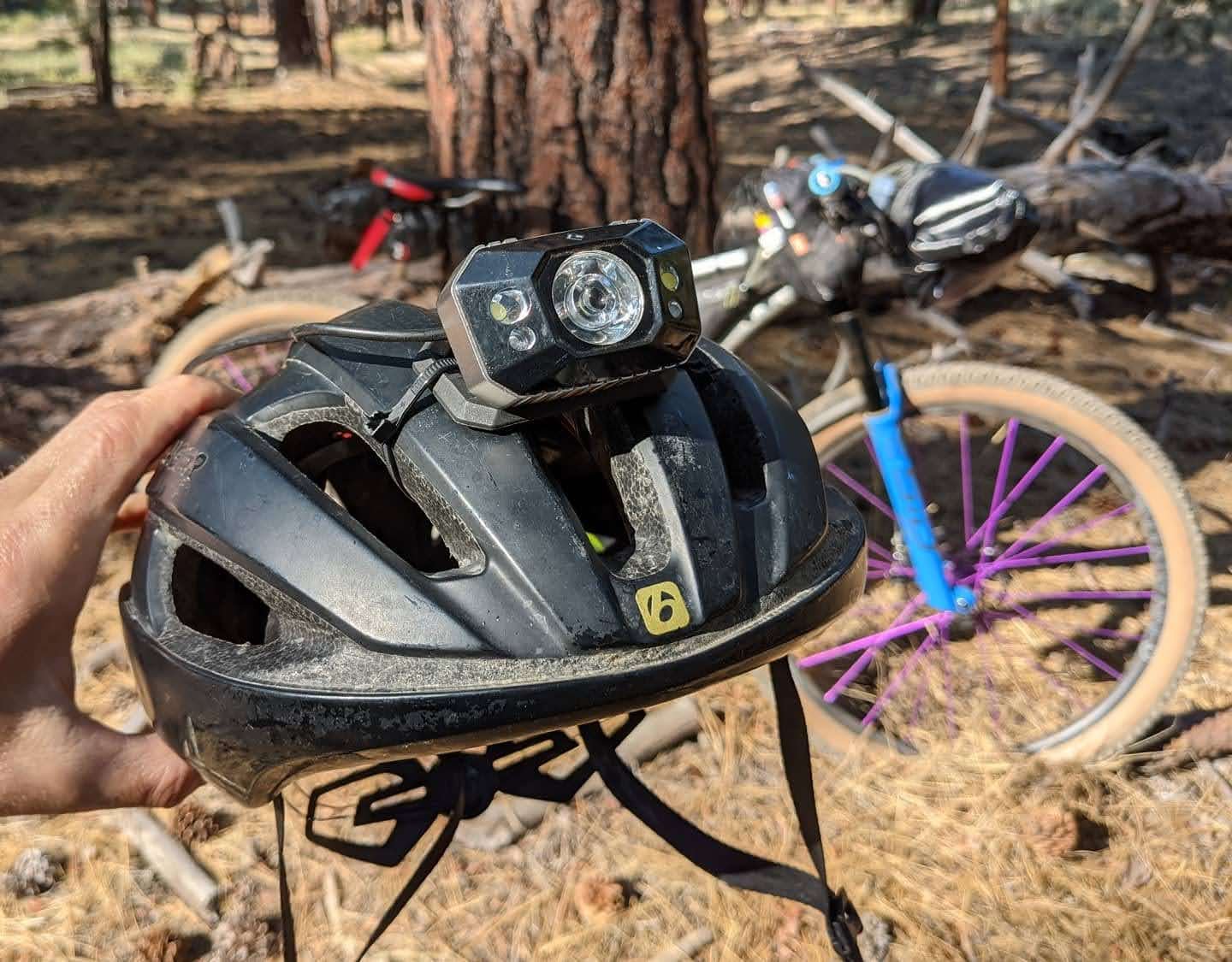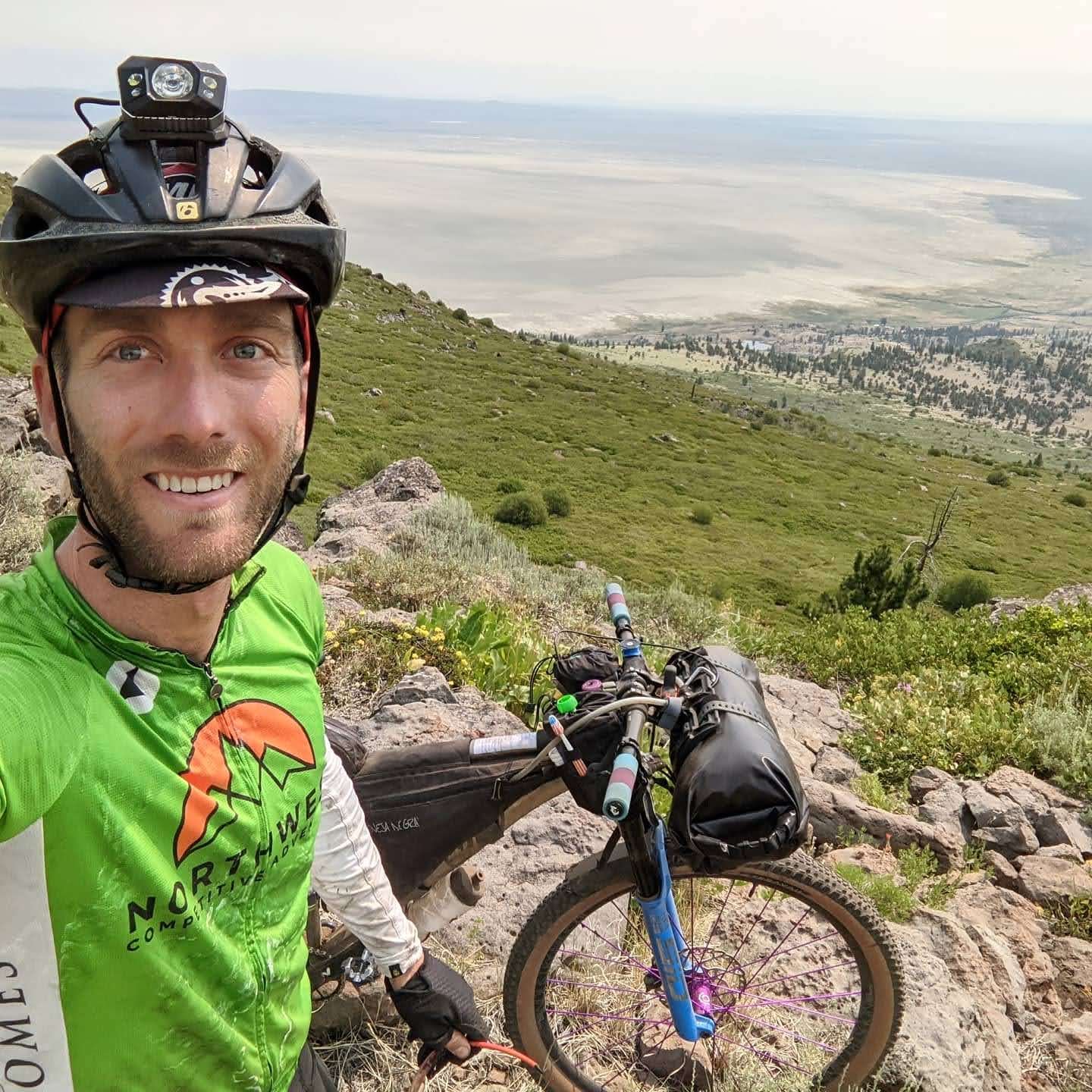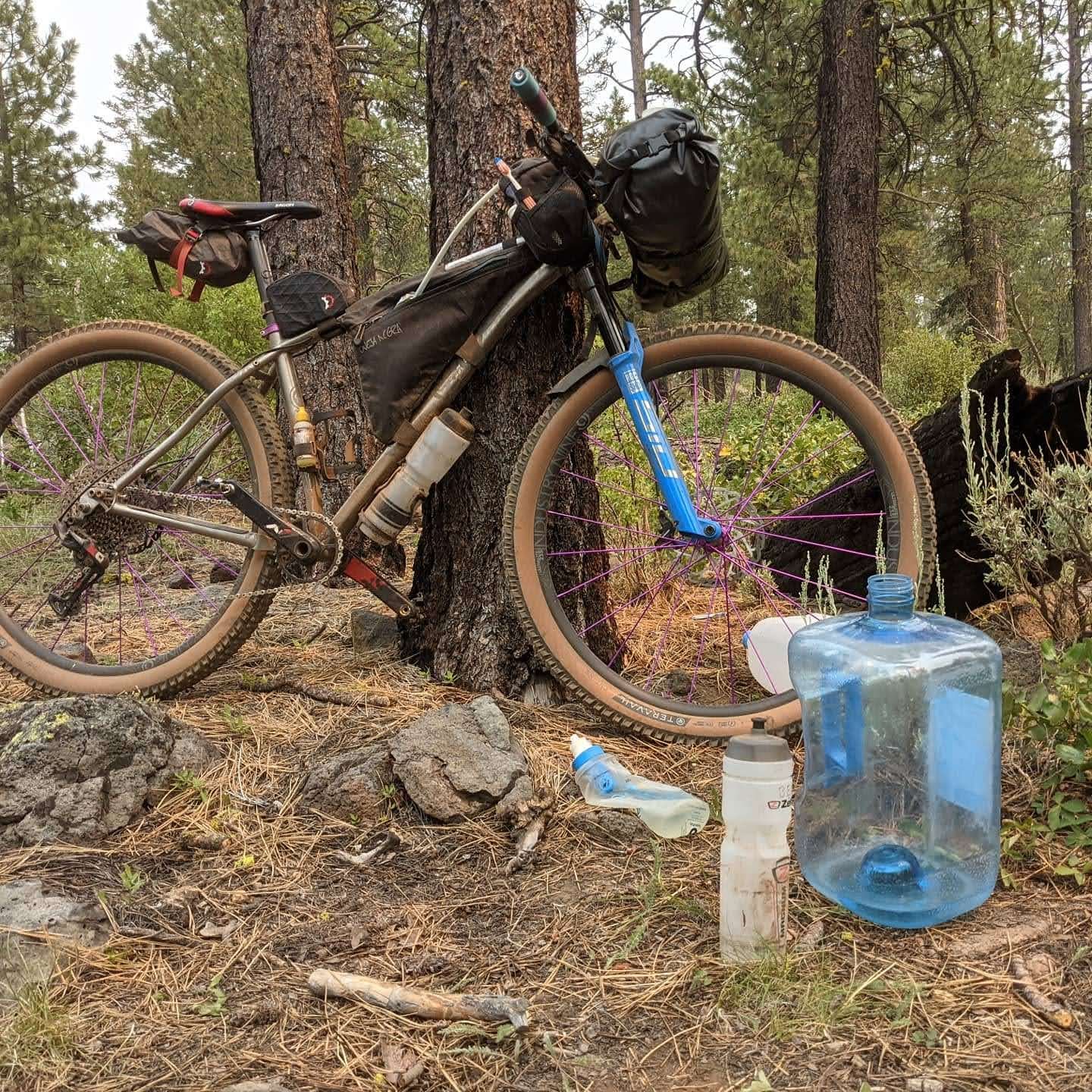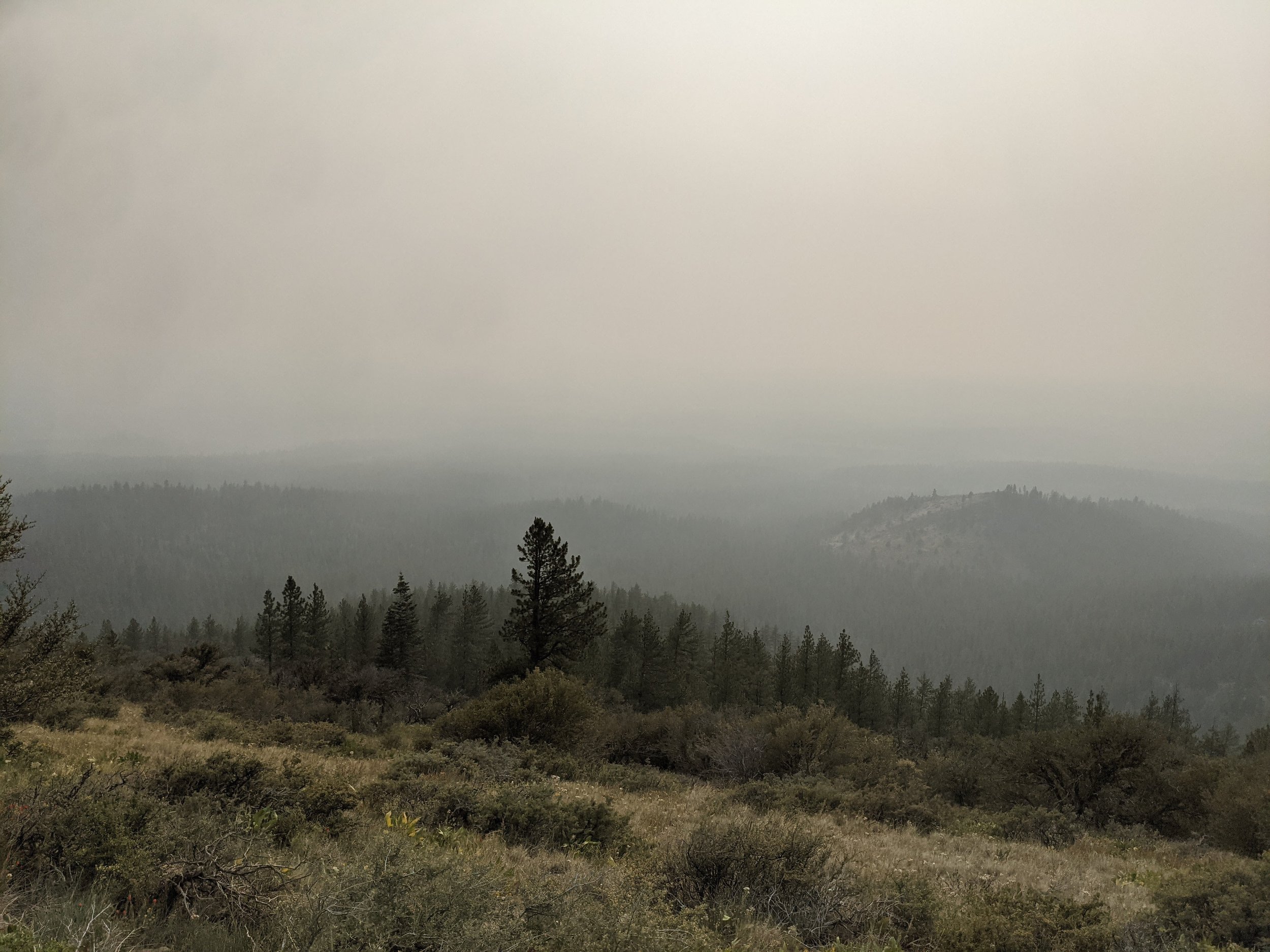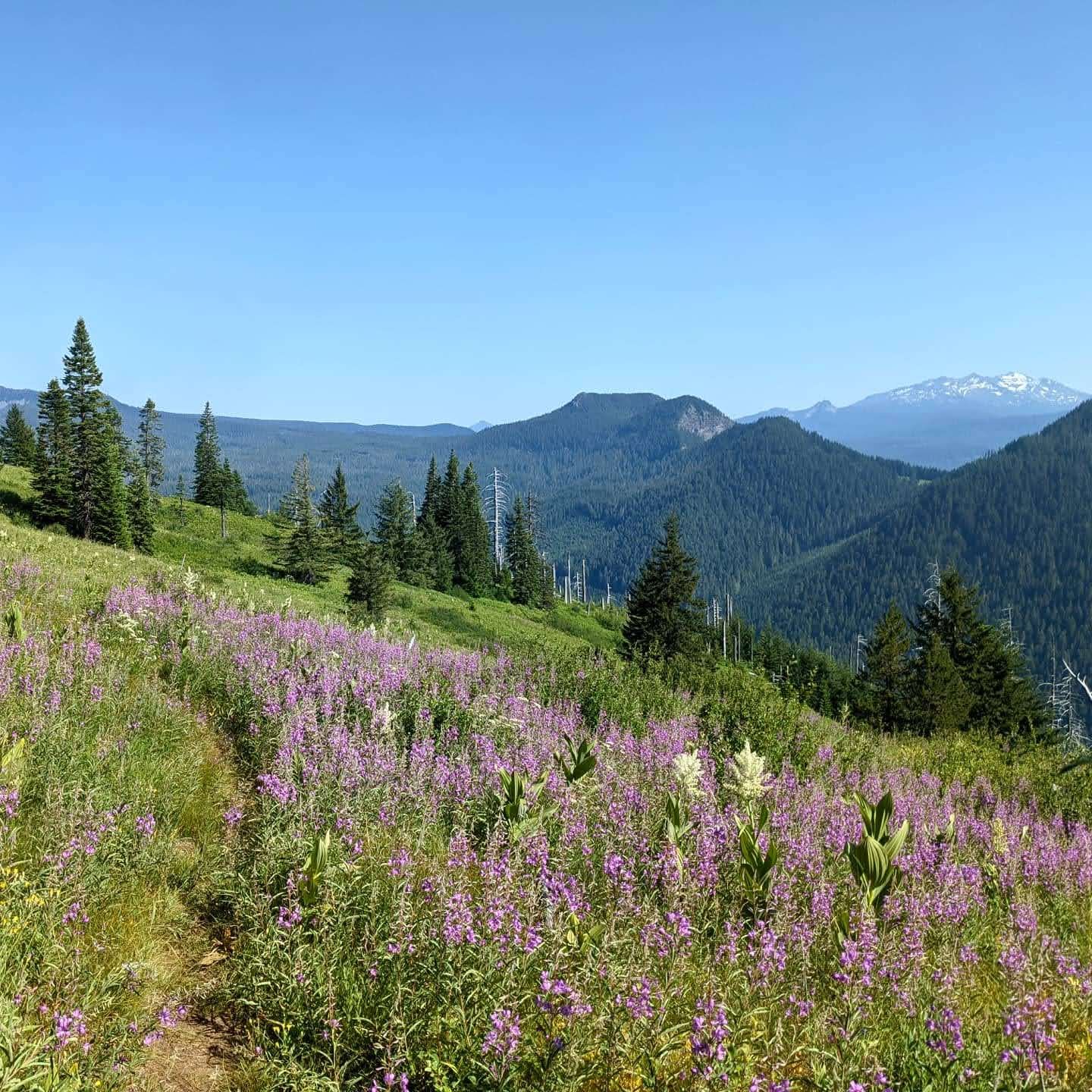At Cave Lake, all geared up and ready to ride the 2021 Grand Depart.
I first met Ben Handrich at Cultus Lake resort in 2017. He was riding the Timber Trail with Miles Arbour. Miles was having trouble with his rear derailleur, so we tried to help with a fix. Fast forward to 2022, and I just happened to have Ben on my thank you call list for donors. Ben also started the “Odyssey of the VOG” 350 mile endurance gravel race on the Oregon coast.
He’s an upbeat and friendly guy, so we had a nice phone chat and we decided to do a little interview. Ben led the Grand Depart this year before having to call it in Sisters due to fire closures. He’s a strong endurance athlete and content creator and he’s stuck with bikepacking over the years, so we asked him about his approach, preparation and his mental outlook. There are a ton of links, ride stories and packing lists here, so grab your morning coffee and dig in!
Tell me a bit about your history as a cyclist.
While I rode bikes with my neighbors as a kid, my passion for cycling didn’t fully develop until adulthood. Throughout middle school, high school, and college, I loved soccer and basketball. Through conditioning camps for these sports, I learned that I had a knack for endurance so I would always go out for the minimum number of X-Country meets needed (3 in my case) during soccer season so I could compete at state each year, but outside of that, I stuck to ball sports. However, once I graduated from college, organized team sports became more challenging to fit into my life whereas running and biking could be squeezed into the cracks between my professional life and bedtime.
Enter cycling. I started road cycling in 2011 and can still remember that first bike purchase: a beautiful black, red, and white Felt Z85. It was one of the most beautiful bikes I ever owned. Then came the commuter/touring bike - a Kona Sutra; then a rigid MTB - a Surly Krampus; and then came the rather inevitable game of selling and buying until I eventually landed an ambassadorship with Why Cycles.
Even with two of the best bikes on the market though - my gravel Why R+ and MTB Why S7 - it’s hard not to dream about the ever-evolving bike industry. For me, the most interesting new wave of bicycles includes the ultralight and small travel full-suspension MTBs like the Scott Spark and Cannondale Scalpel as well as some of the fast ‘all-road’ featherweights coming out now like the Enve Custom road. Even if I don’t plan to buy one of these bikes, it’s fun to follow the trends and try to predict the future of biking.
When was your first bike tour?
My first bike tour was a 650 mile road and gravel (the gravel was unintentional) ride through the Canadian Rockies from Jasper, Canada to Kellogg, Idaho. I did a brief writeup of the experience on my personal blog.
What was your first bikepacking trip?
It was a ride out to Trillium Lake near Mount Hood in 2014, and looking back at my friend Joseph and my ‘bikepacking setups’ is absolutely hilarious. While I just took all of my backpacking gear and strapped it to my newly-purchased Surly Krampus, Joseph opted for a trailer on the back of his Specialized Rockhopper. But you’ve got to start somewhere, right? Neither setup was particularly comfortable on singletrack but it was an incredibly memorable experience and the gateway to countless weekender trips for me.
If you want to read more about that one the blog, Here’s the link
What was your first race?
My first ultra-endurance race was the BC Epic in 2019. I had just finished the Boston Marathon on April 15th, and since the BC Epic was on June 29th that year, I had to do a quick transition from running to cycling.
The Grand Depart was such a transformative experience for me. I love the physical challenge of endurance sports but pushing my endurance mindset into a multi-day event was totally new. The concept of getting to push my physical and mental limits for multiple days was exactly what I was looking for in a sport (Do what you love for multiple days? Sign me up!) and I found through that first race that I wasn’t too bad at it.
There were numerous riders that first day on the BC Epic that looked incredibly fit and were off to the races in the first 20 miles. I hung on for about 10 miles before realizing that the pace at which we were riding wasn’t sustainable for me for an entire day, let alone multiple. It was with a lot of mixed feelings that I watched the front field slowly ride away from me, something I would never do in a day race. But these multi-day races are so different from the day races in Oregon where losing a front group and the benefits of the draft are the difference between a podium spot and a middle-pack finish. Although this was my first race of this scale, my intuition to slow down and settle into a sustainable but competitive pace was the right choice.
Long story short, hanging back and riding my own race resulted in a 4th place finish overall, despite watching over 20 riders leave me in their wake in that first 20-mile segment. While I love marathon and trail running, ultra-endurance biking is definitely my passion and something I’ve put a lot of time, energy, and research into after this initiation into the world of ultra-endurance sport.
The view from Winter Rim. Well worth the climb and baby head chunk
You led the Grand Depart last year. What brought you back to the OTT? How did it change from one ride to the other? This could be about the route specifically, how it felt, how you improved, etc.
Miles and I literally had never met before our ride together and only knew each other through Instagram. Luckily, we both are pretty easy-going guys, so it was a great pairing. Miles was pretty new to mountain biking when he agreed to take this multi-day adventure on, and we both had parallel but different goals. Miles was testing a bunch of gear items for bikepacking.com as well as planning to do a writeup of our ride. You can find Miles’s writeup on bikepacking.com here, and an article about our rigs and packlists here.
Meanwhile, I was planning to do my own writeup of the ride as well as create a video of the route and our experience. You can find my writeup of the route here and my route guide video here.
We both had a great time together, but I was definitely itching to get into racing even as early as 2018, so when I found out the OTT was going to have a Grand Depart in 2021, I immediately knew it was going to be my ‘major event’ of the year.
Since my BC Epic Grand Depart experience in 2019, I had built my own Grand Depart-style race called the Odyssey of the VOG, a 350 mile gravel race that skirts its way through the coast range, and set the FKT for the course at 34 hours on an ITT run in 2021 with my fellow race director Seth Dubois a few weeks prior to the Grand Depart on Memorial Day.
That ITT ride was in May. Coming off the success of that hard push, I felt poised to have a competitive run at the OTT. When you have put in the training, don’t have lingering injuries, and have experienced multi-day events before, it is easier to predict where you’ll roughly end up in these kinds of races, and I knew that, barring major mechanicals or injuries, I should be competing with the front group of riders. The world of ultra-endurance athletes is pretty small and in looking at the list, I knew that Nat Henderson-Cox and Eliza Sempey were the two people I would likely be hop-scotching with throughout the race. However, once the race began, I was able to establish a relatively stable lead on day 1 and then maintain that lead for the majority of the race.
The Oregon Timber Trail is really special because throughout the Fremont Tier and the first 2+ days, I had no cell phone reception and therefore no idea where anyone was until I reached Chemult around mile 200. When I rolled into Chemult and turned my phone on, it was very apparent that the race had become a race of 3: Nat, Eliza, and me. And then the next time I had reception was day 4 in Oakridge, and by then the race had become a race of 2: Nat and me. These Grand Departs are full of twists and turns, and it was really exciting as a racer to have these long ‘dark zones’ where I had no idea what was happening behind me and had to simply focus on my own riding until I entered a reception area.
This year I’m focusing my efforts on the Tour Divide, but the OTT Grand Depart is a race I plan to participate in for years to come.
How have your other ride or race experiences influenced your approach?
I find these races really empowering. Self-doubt is a challenge for me: my fitness, my problem-solving, and other little nuances are things I often question, but these race experiences help reinforce for me my own personal strengths.
Additionally, long rides where I am largely by myself remind me that I actually enjoy my own company. I hear other people say they get tired of themselves when they’re alone and I think that one of my strengths is that I can not just deal with myself on these long trips, I thrive doing long rides by myself. We’ll see if this is the case on the longer Tour Divide this year, but so far, ultra-endurance racing has instilled a deep love for my self-perception, despite all its flaws.
What drives you? Why do you race?
This one is easy for me: I love to compete but I especially love to compete with myself and find where my own limits are both physically and mentally, and ultra-endurance racing is the ultimate self-competition.
You mentioned “physical and mental acceptance” on trail. Tell me about your process of mental and physical preparation
Yeah, physical and mental acceptance are really important in these races. They are going to be so hard if you are a person that is quick to anger or frustration, so learning to physically and mentally accept the ‘now’ - good and bad - is key to whatever ‘success’ means for you out on the trail. For me, acceptance means being happy with my preparation, confident in my gear choices, thankful that I am in a space to do something like a Grand Depart and thankful for people who love and support me. Remembering that once things start, any ‘regret’ that pops up in your head has to be acknowledged and then gently let go.
One example for me this year on the OTT was my lighting choice. I brought along a pretty weak headlamp that did not provide any depth perception on singletrack, and it meant that I had to cut a number of my night rides short and that, when attempting to ride at night, I had to ride very cautiously. Upon realizing this the first night, the automatic negative thoughts started to ping around in my head. ‘You should have brought your stronger backup light, Ben!’, ‘Why didn’t you do more night ride tests with this light?!’, and the list goes on. But it didn’t take long for me to recognize what was happening and redirect my thoughts towards more positive thinking, accepting my reality and recalibrating my goals.
And in my defense, this light revelation was also around the time that ash was raining down like a snowstorm while I was on top of a mountain. I think I was pretty poised for some negative thinking.
What is your favorite thing about the OTT? What would you like to see improved?
The varied terrain and sheer remoteness of parts of the trail are probably my two favorite aspects. The Fremont Tier and Hood Tier couldn’t be any more different in singletrack variability, with the Fremont Tier’s ‘barely there’ trails through incredibly remote wilderness a stark contrast to the Hood Tier’s well-established and world-class 44 trails System.
I believe that there are moments where a bit more signage could be helpful, and the first 100 or so miles of singletrack in the Fremont Tier had a ton of downed trees and sections where the trail literally disappeared. But this is simply part of the trail stewardship process where hopefully as more users seek out the OTT and more volunteers improve it, there will be less deadfall and more established trail throughout. It’s still a new trail and some growing pains are to be expected.
Do you have suggestions for folks that want to race the Grand Depart?
the Grand Depart attracts such a wide variety of riders that it’s hard to know where to start. I guess that as a general rule I would say that as long as you 1) have an emergency contact that can definitely help if needed (there’s a psychological safety component here), 2) ride within your abilities, and 3) come into this ride with at least 100 miles of riding a week as your base fitness, there is no reason you can’t complete this route and have a good time doing it. If those 3 basic components are in place, it is all about your mental game, which I assume is strong if you are considering a ride of this magnitude in the first place.
Do you have ideas about how we can build community along the OTT?
Keep doing what you’re doing! The OTT has developed some really positive relationships with the ‘Gateway communities’ along the OTT, i.e. Lakeview, Chemult, Oakridge, Sisters, Idahna, and Hood River. The more the smaller and less bike-aware communities of Lakeview and Chemult can partner with the OTT, the better!
I know you run the VOG race. How did that come about? Thank you again for helping to raise $ for the OTT. That was amazing! Can you tell us about the different routes on the website?
My friend Seth and I are both pretty passionate bikepackers, racers, and route builders, and after getting to know each other through the BC Epic back in 2019, decided we wanted to build the first self-supported bike race that went through some of our favorite gravel roads in the Siuslaw (my backyard) and Tillamook (Seth’s backyard) forest. We were able to put together a pretty awesome 350 mile gravel route for our Grand Depart that takes place every Memorial Day Weekend, and also break the route into two ‘weekender’ routes that feature the Siuslaw and Tillamook forest separately.
Additionally, the Weekender routes have a few variations from the Grand Depart route that use ‘Day Use Only’ logging roads that are particular favorites of Seth and mine but that we felt couldn’t be used for the Grand Depart since many riders will be riding through the night and camping in these areas.
Our first Grand Depart was in 2021 (last year) and it was an absolute blast. We use it as a fundraiser for the OTT and while the event itself is free, donations to the OTT get the riders into a raffle for a number of awesome products donated by a bunch of awesome companies. We ended up raising around $1,100 last year and hope our riders are just as generous, if not more, for 2022.
Seth made a video of the ride that was posted on The Radavist - it can be found here. And here is our VOG website one more time in case you want to take a look. I think we have about 10 more available slots for this year’s Grand Depart before we close registration, so jump in there if you want to participate in this year’s event! And follow us on instagram at @odysseyvog for pictures of the route, fun facts, updates, and more.
Tell us about your formula to prepare for big races. I know you're doing Stagecoach 400 and the Tour Divide. Is it the same for a gravel race as for a trail race?
Yeah, I follow a pretty regimented and self-built training plan that involves a bit of cross-training (running and weight lifting) and a whole lot of bike miles. I don’t know how far into the weeds to go with this, but basically I lift two to three times a week, run once a week, and then bike between 250-350 miles a week, following (this is very general) a pyramidal training model, which means that ~80% of my workouts fall into what could be considered a zone 2 heart rate workout, and then the other 20% falling into what could be considered zone 3-5 workouts. Since I work full time, this means that I do daily doubles before and after work during the week, and then big rides on the weekends.
I think that many amateur athletes fall into the trap of trying to make every workout a FTP test, a VO2 max test, or an interval workout, and the research around what makes a successful athlete is diametrically opposed to this style of training, and something I fell victim to for many years in my 20s. However, I’ve been following a pyramidal style of training (similar to polarized training) for a while now and have found that I am much less prone to injury and more fit as a result. It’s a win-win.
I also am constantly evaluating the ‘fun-factor’ of my workouts. With such a high training load, I have to be constantly vigilant of passion fatigue. I LOVE cycling and want to always love cycling, so if I find my passion waning, it means something needs to change. I try to stay ahead of cycling passion fatigue by traveling to destinations I haven’t biked before on the weekends, signing up for spontaneous races, testing myself with new challenges, and possibly dialing back the training for a bit if things start to feel monotonous. Luckily, I’m a pretty self-motivated trainer and love the process or ‘journey’ of training. Plus, my partner Trish is incredibly supportive, we both have relatively flexible schedules with our jobs (school counselor and Oncology nurse), and with no kids in the picture are able to be pretty spontaneous and mobile. People are always welcome to reach out to me if they want to go ‘into the weeds’ on this,
One surprising thing about you that most folks don't know?
After high school I lived near Kingston, Jamaica for a year working for a nonprofit where I taught elementary school students literacy skills through a donated computer lab in the small town of August Town. In the first few weeks of working there, I was in a highway vehicle collision that resulted in our van rolling off the highway and me breaking through one of the windows with my head, landing about 20 feet from the van. It was not a great way to start my year in Jamaica. :)
Months later through what can only be described as serendipity, I met one of the witnesses of the crash. When I told him that most of the passengers in the vehicle were thrown through the windows he was absolutely shocked. ‘I thought I was watching luggage fly out the windows as the van rolled!’ he exclaimed.
Nope, those were bodies.




